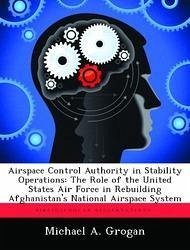Despite a decade of war with the former Soviet Union, followed by years of harsh Taliban rule, Afghanistan still had a rudimentary national airspace control system prior to the start of Operation Enduring Freedom (OEF). However, very little of Afghanistan's air traffic infrastructure could be leveraged to safely support Coalition flight operations. Therefore, to ensure aviation safety, U.S. military forces shouldered the burden of providing airspace control for the country, to include all civil operations, and continue doing so to this day. This paper examines the United States Central Command Air Forces' (USCENTAF) role in rebuilding Afghanistan's national airspace system during stability operations. Most issues presented are from the operational-level of command but have significant strategic-level implications. Ranging from the challenges of mixing military and civil aircraft operations to affecting aviation commerce of a nation, the analysis of these issues is focused through the doctrinally recognized lens of an airspace control authority (ACA).
Hinweis: Dieser Artikel kann nur an eine deutsche Lieferadresse ausgeliefert werden.
Hinweis: Dieser Artikel kann nur an eine deutsche Lieferadresse ausgeliefert werden.








